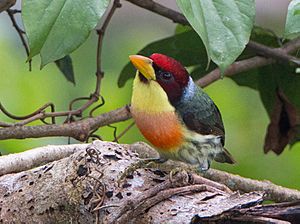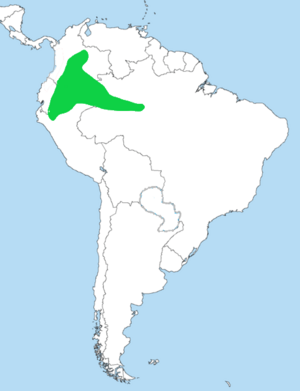Lemon-throated barbet facts for kids
Quick facts for kids Lemon-throated barbet |
|
|---|---|
 |
|
| Male E. r. richardsoni | |
| Conservation status | |
| Scientific classification | |
| Genus: |
Eubucco
|
| Species: |
richardsoni
|
 |
|
The lemon-throated barbet (Eubucco richardsoni) is a colorful bird that belongs to the New World barbet family. You can find this bird in several South American countries, including Bolivia, Brazil, Colombia, Ecuador, and Peru.
Contents
About the Lemon-throated Barbet
Scientists group living things to understand them better. The lemon-throated barbet is recognized by major bird organizations like the American Ornithological Society. It has four main types, called subspecies:
- Eubucco richardsoni richardsoni (the main type)
- E. r. nigriceps
- E. r. aurantiicollis
- E. r. purusianus
Sometimes, the aurantiicollis type is even considered a separate species, called the flame-throated barbet, because it looks a bit different.
What Does It Look Like?
The "lemon-throated" barbet is about 15.5 cm (6.1 in) long. That's about the length of a pen! It weighs between 24.5 to 34 g (0.86 to 1.20 oz).
- The male of the main type (E. r. richardsoni) has a bright red top of its head, a gray-blue neck, and green upper parts. Its throat is yellow, its chest is orange-red, and its belly is greenish with dark stripes.
- The female is not as brightly colored. She has a gray-green head and upper parts. Her throat is bluish, her chest is orange-gold, and her underparts are bluish-yellow with dark stripes.
- The male E. r. nigriceps has a black head, and both males and females of this type have blue-green upper parts.
The "flame-throated" barbet types are a little heavier, weighing 26 to 42 g (0.92 to 1.48 oz).
- E. r. aurantiicollis has a yellow neck, yellower-green upper parts, a more orange throat, and a redder chest compared to the main type.
- The female E. r. aurantiicollis is similar to the main type's female but has less yellow on her throat and chest.
- The male E. r. purusianus is lighter in color than the main type and has a pinker chest.
- The female E. r. purusianus has an orange-gold chest band, just like the main type's female, but it's narrower.
Where Does It Live?
The lemon-throated barbet lives in the western part of the Amazon Basin. Each of the four subspecies lives in slightly different areas:
- E. r. richardsoni: Found from eastern Colombia, south through eastern Ecuador, and into northern Peru.
- E. r. nigriceps: Lives in northeastern Peru and extends east into far western Brazil, north of the Amazon River.
- E. r. aurantiicollis: Found from eastern Peru east into western Brazil, south of the Amazon, and south into northwestern Bolivia.
- E. r. purusianus: Lives in western Brazil, south of the Amazon River.
These birds all live in similar places:
- Lowland forests, especially "terra firme" (forests on higher ground that don't flood).
- Dense secondary forest (forests that have grown back after being cut down).
- The edges of these forests and clearings.
- They can also be found at the edges of várzea forest (forests that flood seasonally).
They are more common in forests near rivers and lakes that are still growing, rather than in very old, mature forests. They live from lowlands up to about 1,375 m (4,511 ft) high in Colombia, and similar heights in other countries.
Behavior
Feeding Habits
The "flame-throated" barbet eats both fruits and arthropods (like insects and spiders), about half and half. It usually looks for food alone or in pairs. It can be found foraging from the very tops of the trees down to about 5 m (16 ft) from the ground, but it most often feeds between 12 and 24 m (39 and 79 ft) high.
These birds often join mixed-species foraging flocks, which are groups of different bird species looking for food together. They spend a lot of their time (more than one-third) searching for insects hidden in dead leaves. Scientists believe the "lemon-throated" barbet eats and forages in a very similar way, even though it hasn't been studied as much.
Reproduction
The "lemon-throated" barbet seems to have its breeding season from April to November, though it might start as early as February. We don't have much information about their nests or eggs yet. The "flame-throated" barbet's breeding habits haven't been studied in detail either, but its breeding season is thought to begin earlier than the main type.
Vocalization
The songs of the different lemon-throated barbet subspecies are quite similar. Their song is described as soft, quick, trill-like "hoo" notes, usually in groups of two or three. They also make various grunting and snarling sounds.
Conservation Status
The IUCN (International Union for Conservation of Nature) looks at how many of a species are left in the wild. They consider the Eubucco richardsoni and E. aurantiicollis as separate species. Both are currently listed as "Least Concern." This means that even though their populations are not known and are thought to be decreasing, they are not yet in danger of disappearing. These birds also live in several protected areas, which helps keep them safe.
See also
 In Spanish: Cabezón pechiamarillo para niños
In Spanish: Cabezón pechiamarillo para niños


